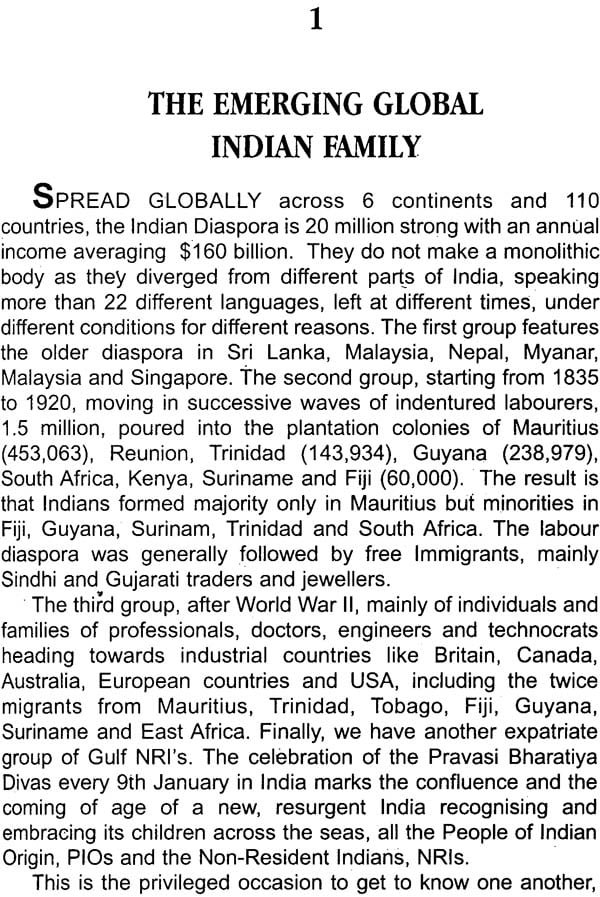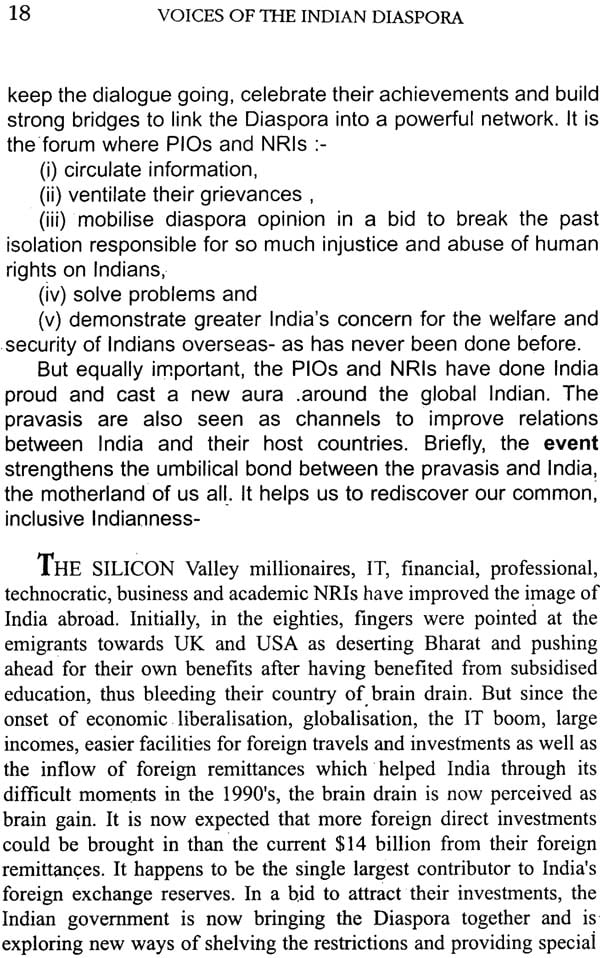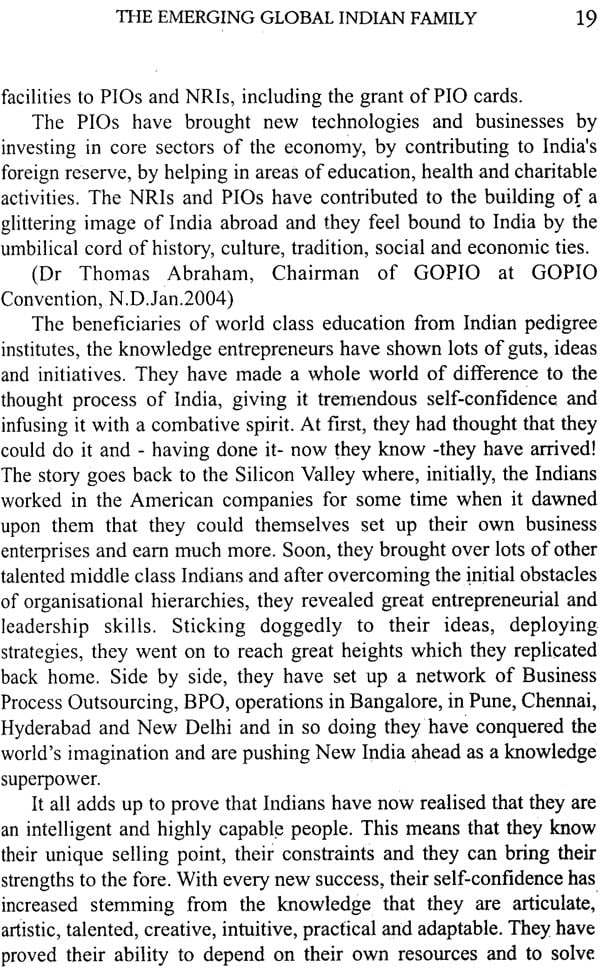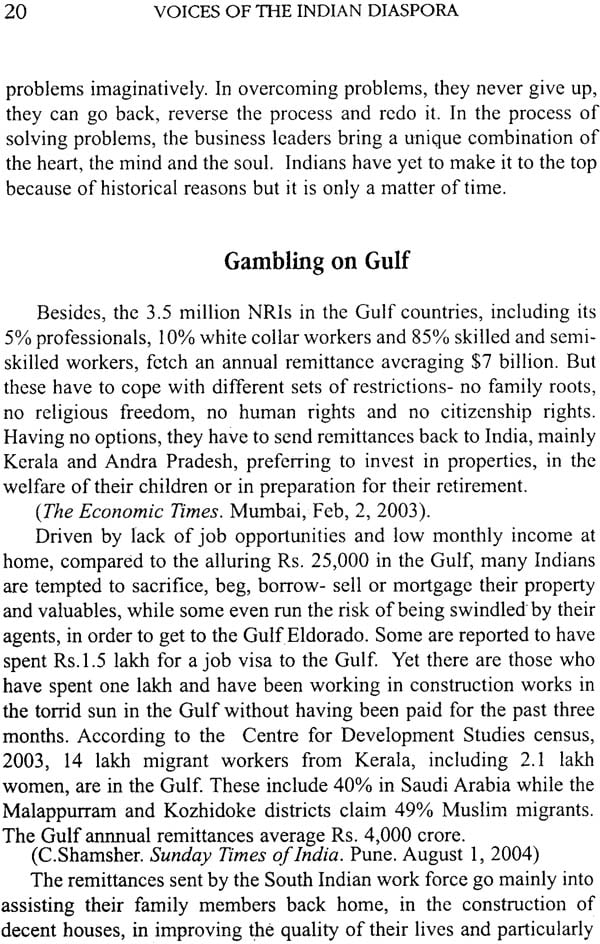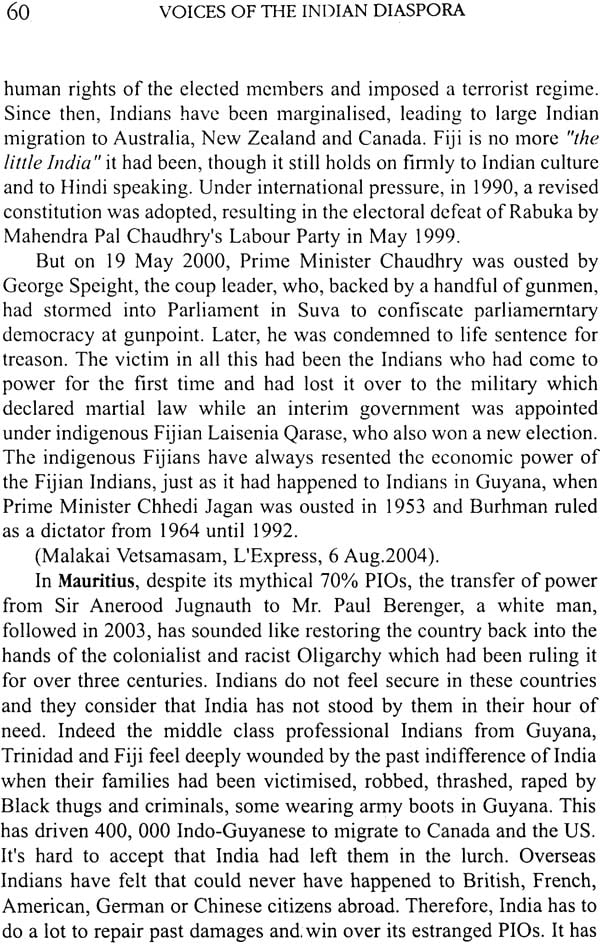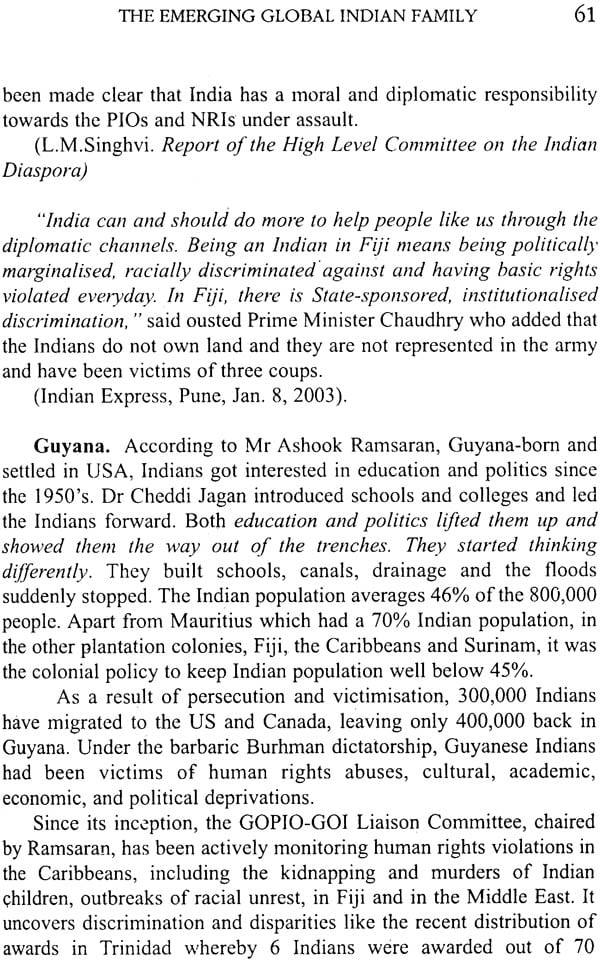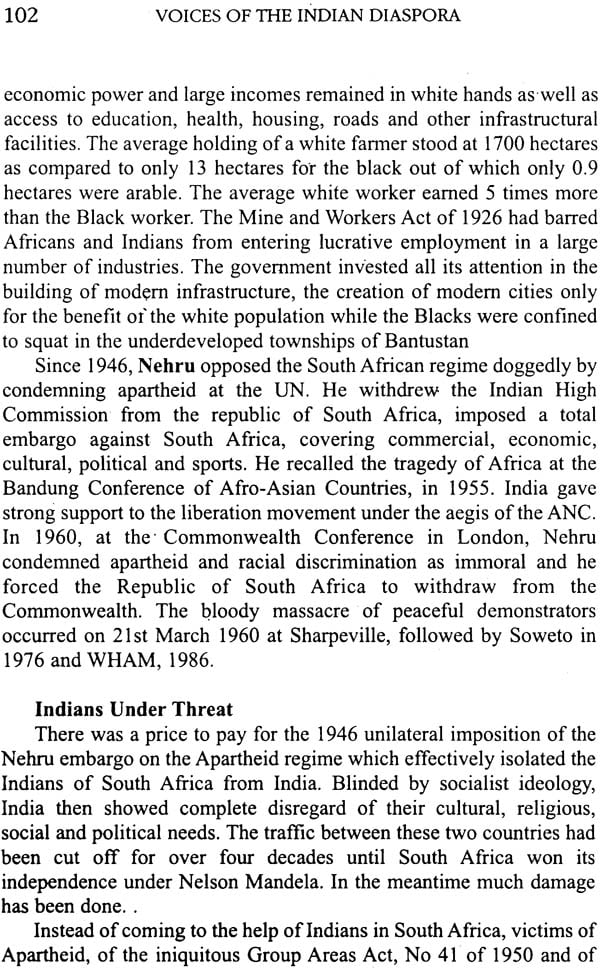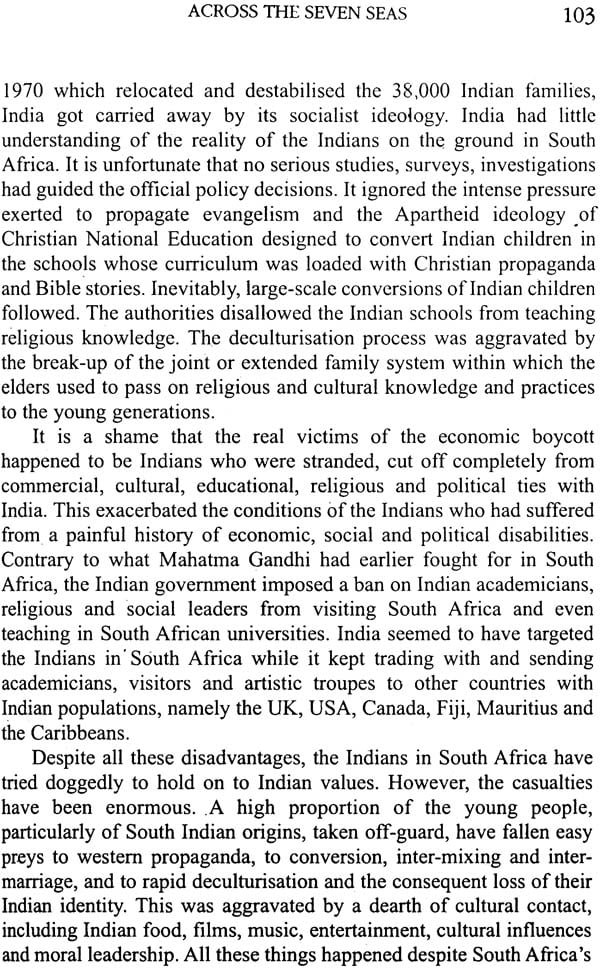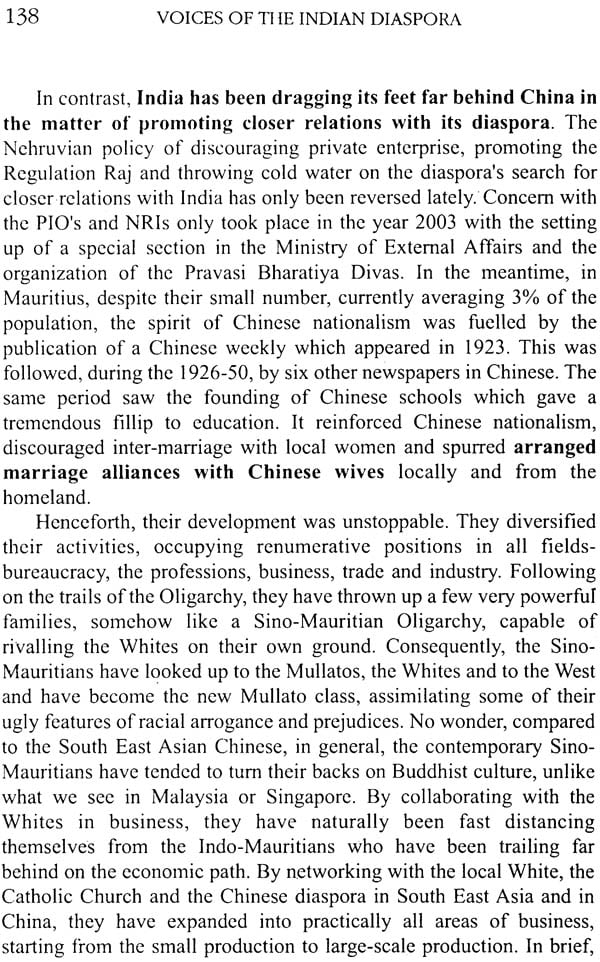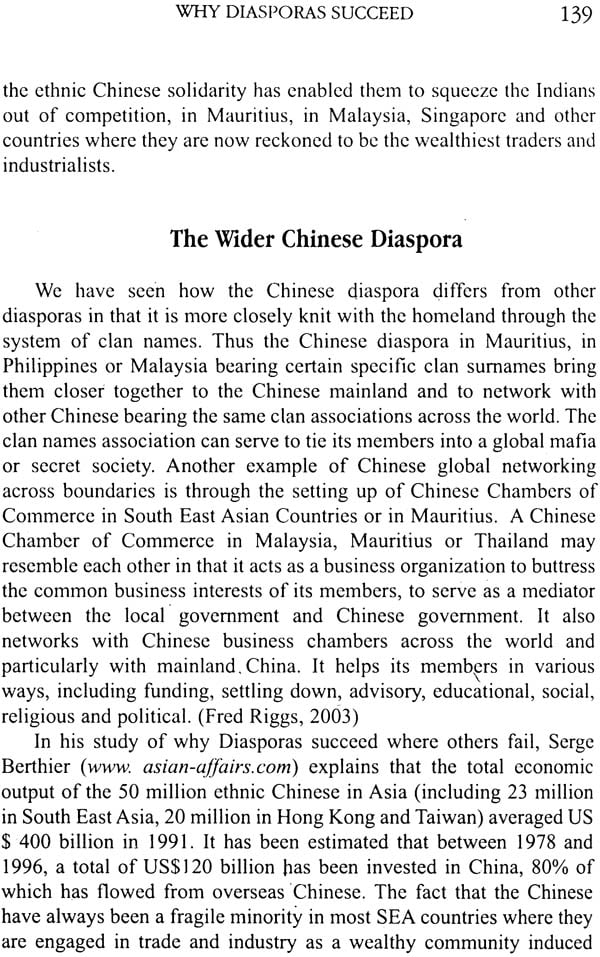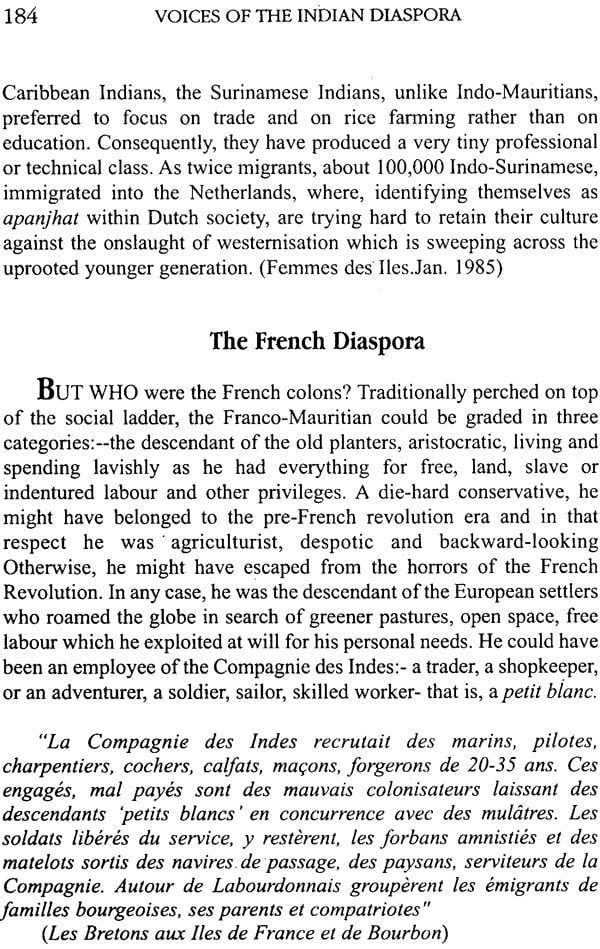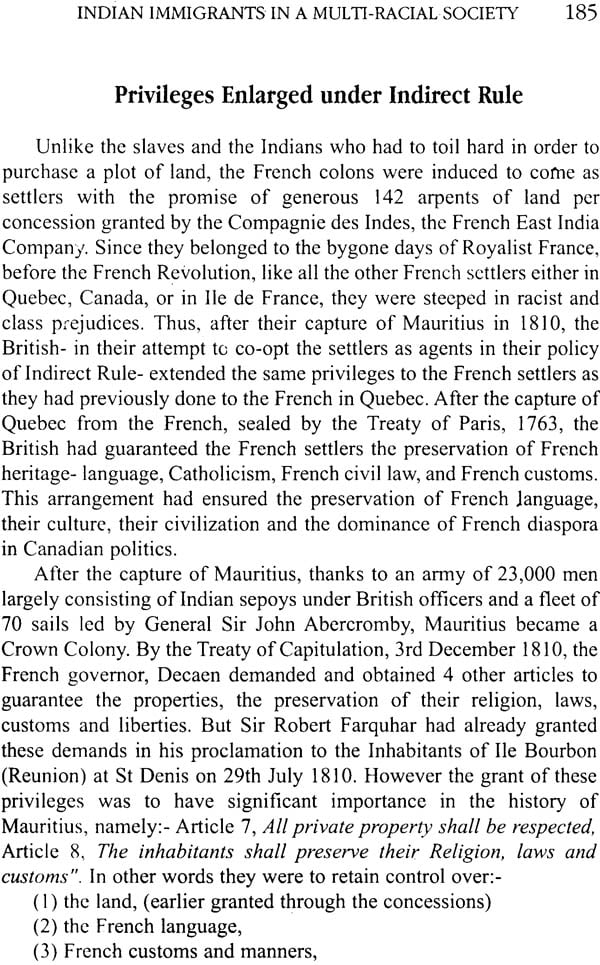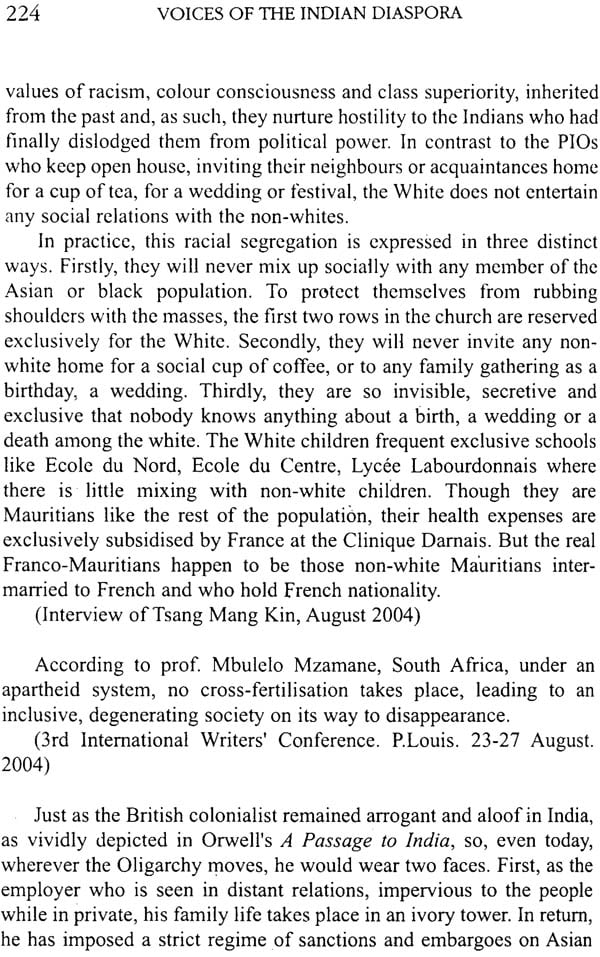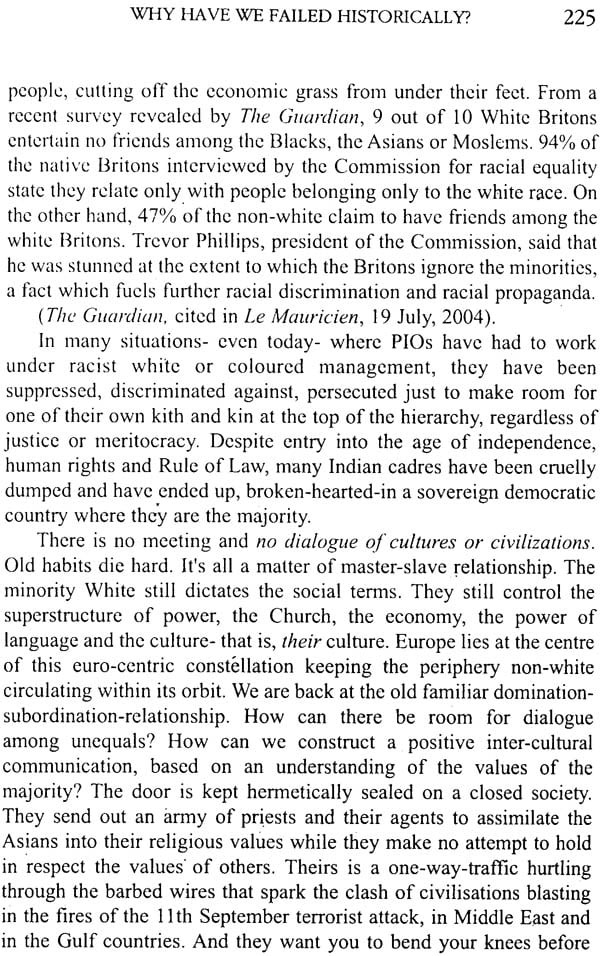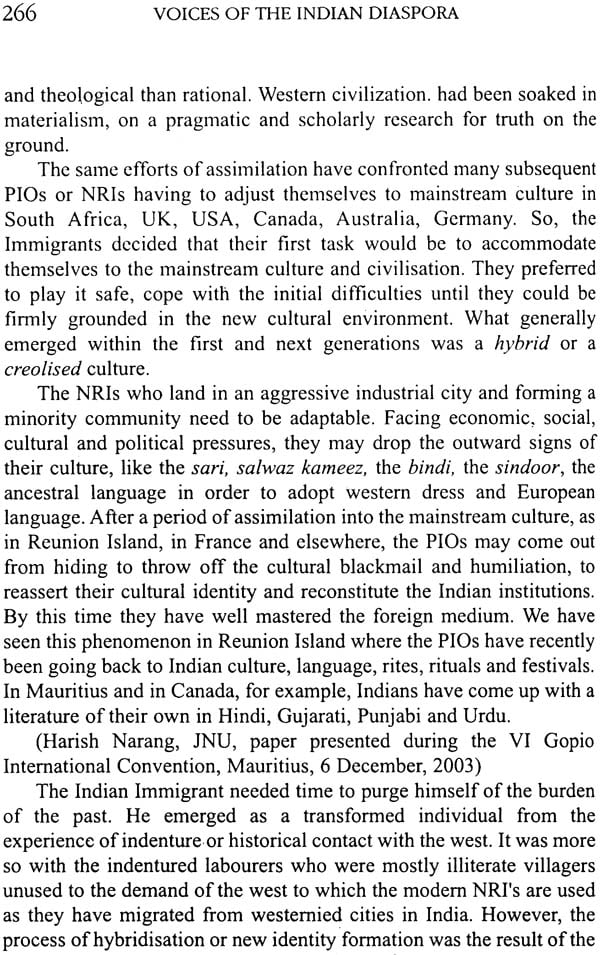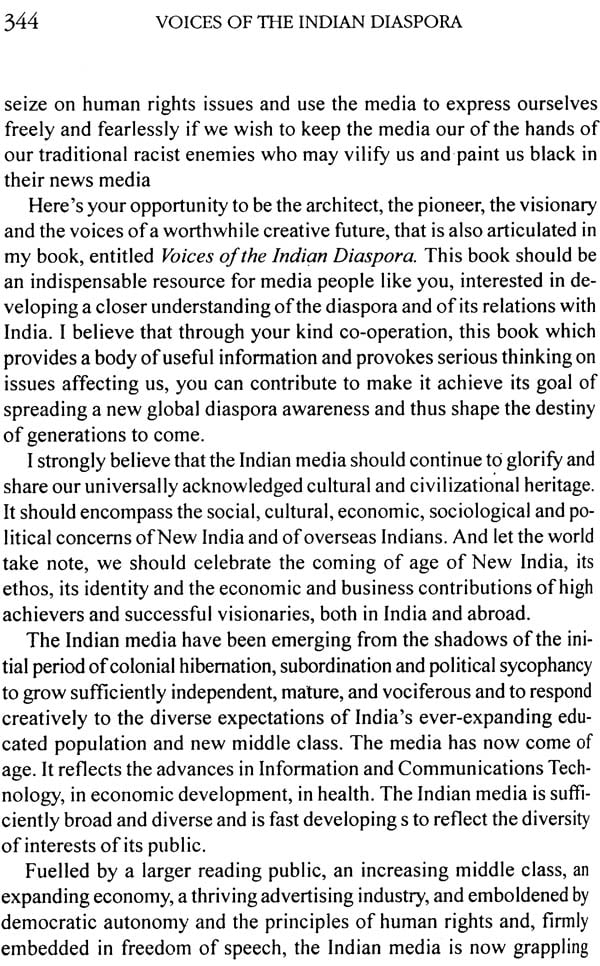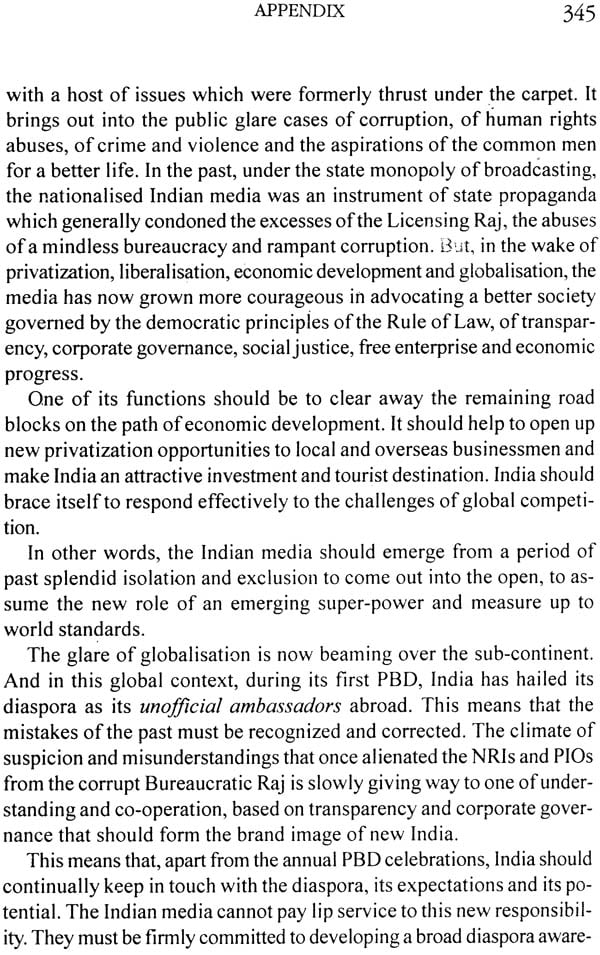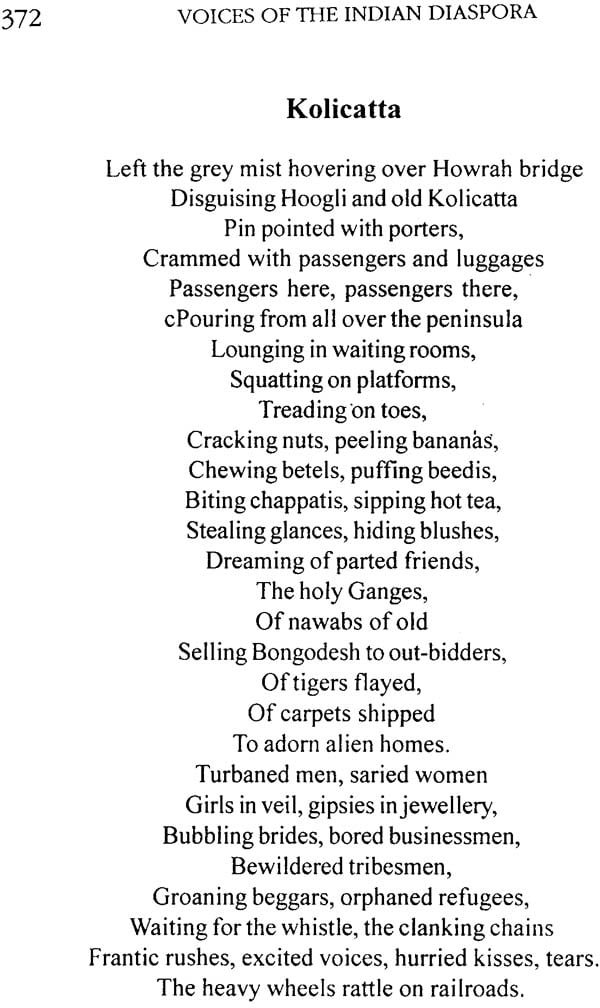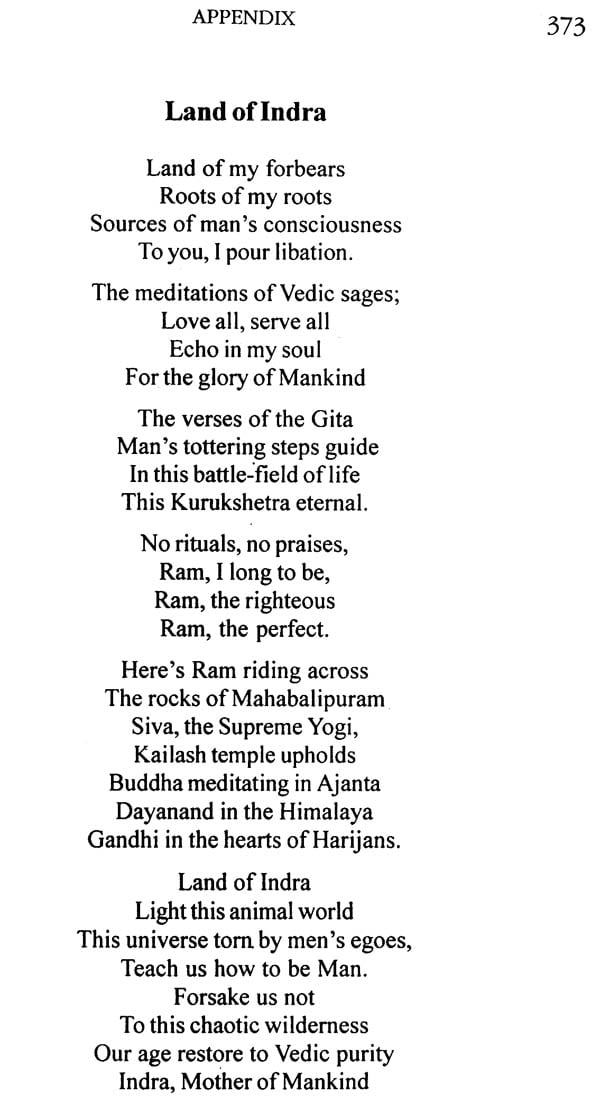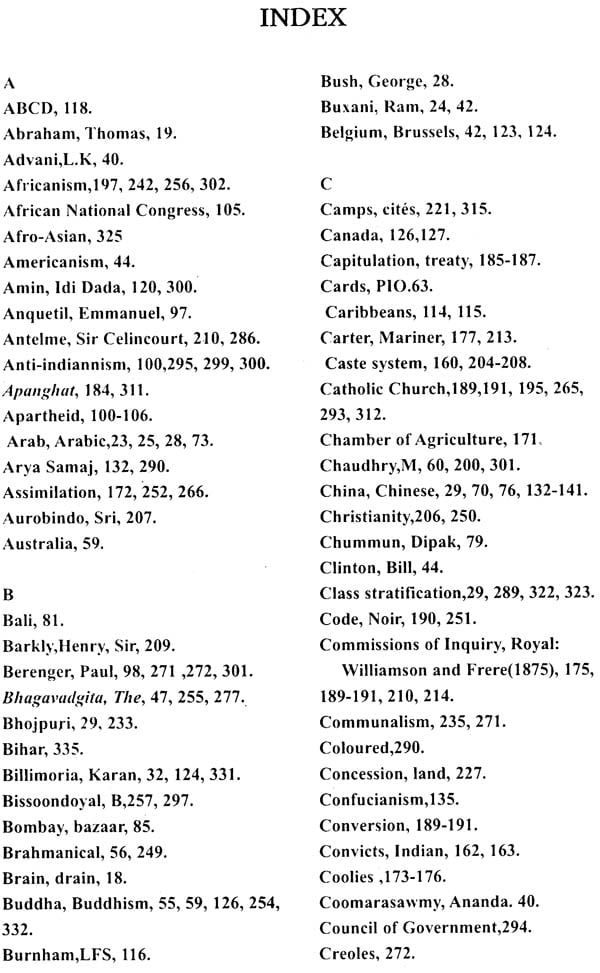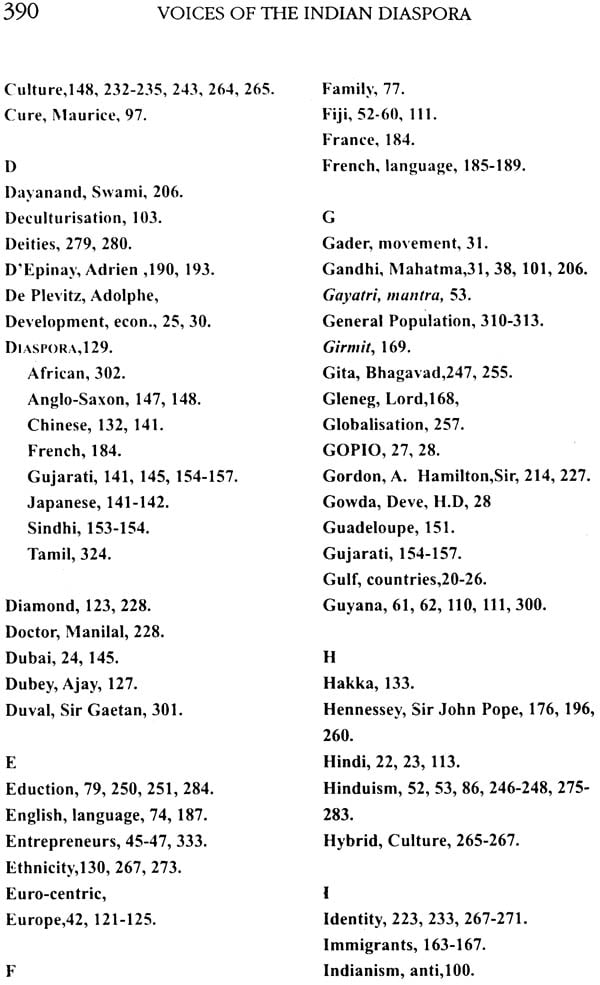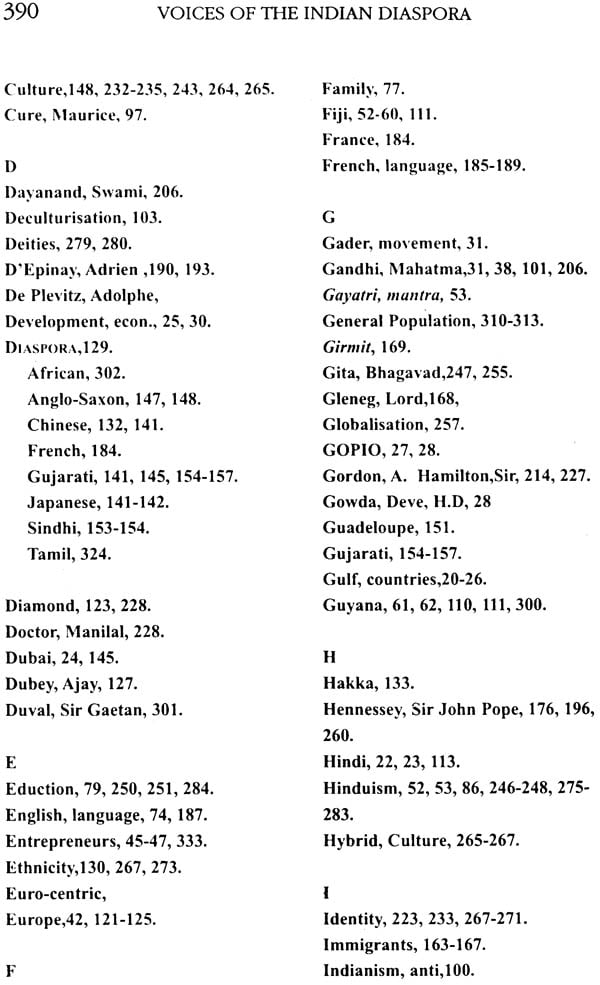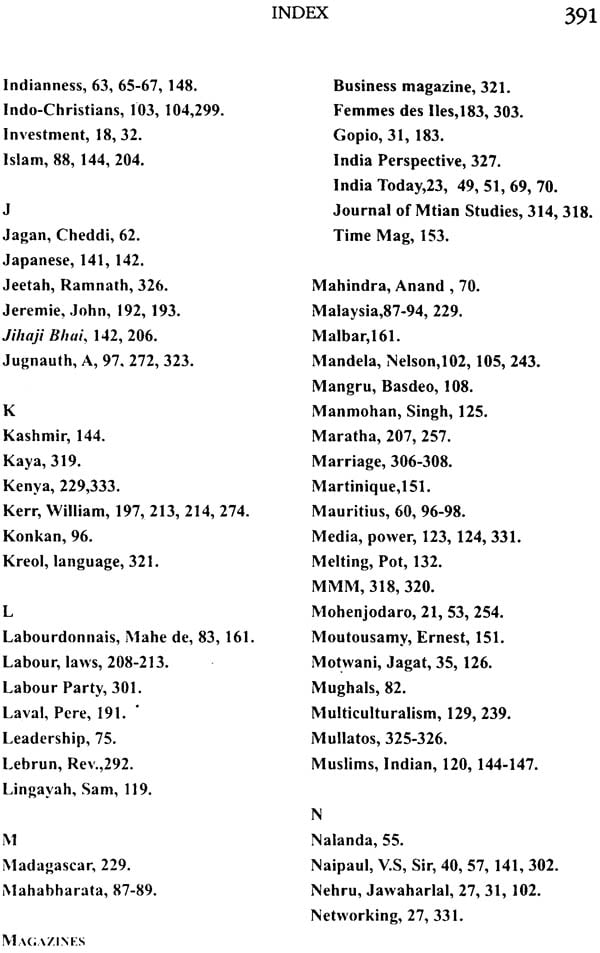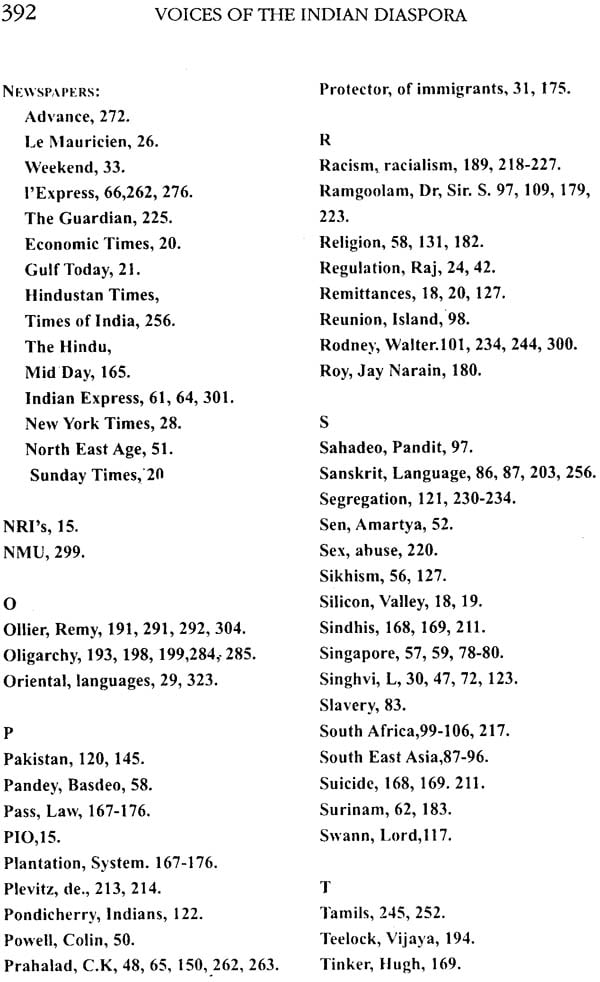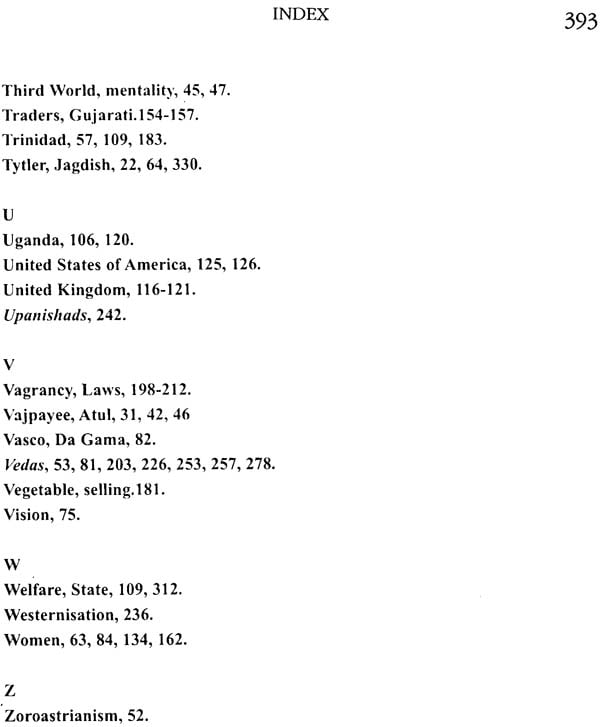
Voices of The Indian Diaspora
Book Specification
| Item Code: | IDJ341 |
| Author: | Anand Mulloo |
| Publisher: | Motilal Banarsidass Publishers Pvt. Ltd. |
| Language: | English |
| Edition: | 2007 |
| ISBN: | 9788120831971 |
| Pages: | 393 |
| Cover: | Paperback |
| Other Details | 8.0 X 5.3" |
| Weight | 390 gm |
Book Description
Foreword
Voices of the Diaspora is a marvelous collection of the contemporary and historical experiences of the Indian Diaspora in different parts of the world. It reveals the accomplishments, the issues and problems faced by overseas Indians. The book also uncovers the potential of the 22 million People of Indian Origins for development in India as well as the countries with large Indian population. It indicates some of the reasons which have so far held back the NRIs and PIOs from actively pursuing investments and business opportunities in India.
Quoting several world leaders, Anand Mulloo shows what lies ahead of India on its way to becoming a world power. He maps out the need for leadership with vision, for social infrastructure, for work culture, education, individual and social responsibility.
Anand Mulloo has taken it upon himself to do an extensive research into the Diaspora by traveling around, collecting information and interviewing people. Very few people can do it. I want to compliment him on doing such a thorough job.
The author highlights the importance of networking the Indian Diaspora, based on the objectives and accomplishments of the Global Organization of People of Indian Origins (GOPIO) he shows how the tradition of openness of the global Indian family goes back to the Vedas, the mother of religions and philosophies.
In the wake of the Government of India's High Level Committee report, media accounts and other studies on the diaspora, Anand Mulloo has provided the best update on political situations and issues in countries such as Fiji, Trinidad and Tobago, Guyana and others. He talks about the implications and advantages concerning the PIO Card and Dual Citizenship.
The writer analyses the causes of success and failures of the Indian Diaspora in the countries of their adoption. He explains why Overseas Indians have been more successful in western countries than in certain developing countries. He advocates closer community relationships in order to ensure PIO success as a whole.
The book covers a detailed description of the migration of Indians overseas since ancient times and particularly during the last two centuries. It offers us a good comparison of the similarities and differences between the earlier Diaspora, termed (PIOs) and the newer immigrants (termed NRIs). The author describes in depth the history of Overseas Indians, their trials and tribulations in settling down, relationships with other Diaspora communities, African, Anglo-Saxon, Chinese, French within the host countries.
Voices of the Diaspora is a must book for business entrepreneurs, students, academicians, historians, community activists, philanthropists, diplomats, both Indian and PIO political leaders and all those interested to know more about the 22 million PIO communities settled in more than 160 countries, it is a valuable contribution to the growing literature on Diaspora Studies.
Back of the Book
Spread over a wide canvas, but focused entirely on the Indian diaspora, Mulloo attempts a diasporic perspective by using the interdisciplinary tools of history, economics, politics and sociology to narrate the story of overseas Indians. Secondly, he makes an important departure by taking a self-confident, indo-centric view of a resurgent India - but from a self-critical, realistic and optimistic perspective. Thirdly, Mulloo's analysis of NRIs and PIOs provides the intellectual framework for a deeper, critical understanding of the Indian diaspora - that global family of 22 million in over 125 countries. Finally, he positions the Indian diaspora, with its estimated combined income of $160 billion, as a huge asset in the creation of a global network and the building of economic bridges to assist both India and the host countries.
Written in an easy readable style and shorn of academic jargon, Voices of the Indian Diaspora is a contemporary effort at understanding overseas Indians. It is honest, compelling, thought provoking and substantial.
Mulloo's understanding of and love for India's great civilizational heritage is the recurrent theme of this book. But that does not prevent Mulloo from recognizing India's weakness and suggesting practical means to overcome them.
Anand Sawant Mulloo, former Head of Department of History, John Kennedy College, lecturer, Mahatma Gandhi Institute, Mauritius, has held various responsible positions in media and educational administration at ministerial, private and parastatal levels.
Author of novel, Watch Them Go Down (1967), Dust of Time-collection of poems (1968), Our Struggle (1982), father of the Nation (2000), How your Child Cab be a Winner (2003), and former editor of Femmes des lies magazine, member of GOPIO Academic Council, Anand Sawant Mulloo offers us an interesting blend of his personal narrative style.
He has been conferred the "Hind Rattan Award" by the NRI Welfare Society on the January 25th 2007, at New Delhi.
VOIES OF THE DIASPORA lends a voice to the 20 Million PIOs and NRIs spread in 125 countries speaking more than 20 languages, professing all the major religions of the world and reflecting the global society. For too long, the voices of the diaspora have gone unheard and their stories have remained unsung. The Indian Immigrants and their descendants have gone through a variety of historical experiences and sacrifices which need to be told so that we remember their sufferings and services, disappointments and hopes and draw the necessary lessons. We have to understand them and remain faithful to those lessons in order to ensure a better future for the diasporic children.
In a bid to articulate the voices of the repressed people, we have ventured across untrodden paths, left unexplored by many writers and historians. This book throws light on some of the controversies, failures and merits of the diaspora, including their social, cultural, religious, psychological, economic and political orientations, threats and aspirations.
Here, to give an insider's view of the Diaspora, we shall take up the story of an Immigrant family and follow up its journey across times. And while firmly grounded in real life situations, enlivened with stray biographical and historical details in chronological and thematic order, it outlines the diasporic similarities and differences in a comparative perspective. It addresses our broader diasporas- their social, cultural, religious and political organisations, their aspirations, their challenges, their shortcomings, their contributions and their achievements- with a few probing questions and insights thrown in.
It covers the historical movements which have shaped the diaspora, including the legacies of slavery, indenture, colonialism, assimilation, domination, subordination, marginalisation, resistance, decolonisation, Cold War, struggle against Apartheid and the new disaporic awarensess. Underlying it all is a deep spiritual message, the same that sustained the human spirit against all the overwhelming odds during the trying days of early immigration.
It maps out the diasporic space within which the issues of ethnicity, identity, racism, culture, class and power relations are played out in the daily lives of Indian immigrants scattered around the globe. It unfolds the context in which the Indian diaspora has collided, enmeshed with, resisted the British, French, Black and Chinese diasporas and how a transformed Indian diaspora is being constructed. The study of Indian diaspora in its relations to other diasporas enables us to take on board the burning issues of racial conflicts, religious wars, political strife, ethnicity, gender, sexuality, cultural, economic, social, political and psychological interconnections.
In the process, we shall adopt a multi-disciplinary approach, and spice the narrative with some of the concepts, data, findings. methods, theories and tools pouring from many disciplines, ineluding anthropology, economics, history, geography, journalism, literature, politics, sociology and refer to the works of scholars in these fields. This book provides the intellectual framework for a deeper understanding of the diaspora.
We shall have to deal with the interrelationships of the dynamic forces of education, economic development, trade opportunities and networking and the past, the present and future of global Indian communities. Some of these issues have now been dragged from under the carpet so that we can see ourselves face to face, with our plus and minus points, in the social and historical mirror. The debate is now open. Our aim is not only to foster self-awarenesss and .awareness of our inter-personal relations within our diasporas but also 'to provide the necessary tools for academicians, leaders, legislators, media people and all those concerned with PIOs and NRIs to reflect on these issues and take the necessary actions
This book is a rallying call to us all, the children of Mother India, to believe in ourselves, in .our collective destiny and to draw inspiration from our glorious cultural and civilizational heritage. It demolishes the myths, the misunderstandings and prejudices which have held us back in the past. Its central message is to take a fresh look at the emerging new India, the awakening giant and superpower- seen from a self-critical, realistic but optimistic perspective. At the same time, it does not shy away from exposing our limitations which historically stemmed from the sub-continent. The idea is to face up to our waeknesses, take the. necessary corrective measures and move forward. Briefly put, the book proposes a complete turn-around, a shift of emphasis from the traditional Euro-centric to a dynamic, self- . confident Indo-centric approach.
This saga of the Indian diaspora and - in many respects a success story- spearheaded by the Global Organization of People of Indian Origins, GOPIO, has won global recognition. It is celebrated every 9th January during the Pravasi Bharatiya Divas, in India. It is now garnered as a precious part of the global Indian consciousness. In some way, this book tells us about our dynamic and fast changing Diaspora, what Mother India expects of her children overseas and what is expected of her.
By NRI is meant Non-Resident Indians who may happen to be first generation migrants in western or Gulf countries while PIO refers to Persons of Indian Origins, the descendants of the NRI or second, third and successive generations of Indian Immigrants. In other words, today's NRIs may become tomorrow's PIOs.
But first of all, we have to contextualise the diasporic issues. We need to know who the PIOs and NRIs are, where they come from, their diversity; something about their history, their geography, economics and politics, their cultural base and their relations both to their host countries, to other diasporas and to the homeland, India. Among other concerns, we shall look into the Immigration laws, the problems of the preservation of their culture, language, religion and ethnicity in the face of assimilation, domination and race relations.
We shall review their family life, their cultural, social and religious activities and their political participation and unearth any human rights problems. We shall also consider their main occupations, contributions, problems and achievements.
We shall also explore their internal relations with other sub-ethnic groups within the Indian community as well as with other ethnic or racial groups and see how they compare and contrast with other diasporas within their countries of adoption
What are their vast ramifications, their varied needs and expectations and their potential as well as the complex and diverse multi-cultural societies within which they operate'? These and other issues are explored in Voices Of The Diaspora
| Acknowledgments | 9 |
| Foreword | 11 |
| Introduction | 13 |
| Chapter 1 | 17 |
| THE EMERGING GLOBAL INDIAN FAMILY | |
| Gambling on Gulf | 20 |
| We have Arrived | 26 |
| Home and Away from Home | 30 |
| GOBIO | 34 |
| Singhvi's HCL Report | 37 |
| A Spoke-and Hub-Relationship | 38 |
| Ten Celebrated Global Indians | 39 |
| The Ripple in the Pool | 40 |
| India-A Global Dynamo | 43 |
| You have to be a Giant | 45 |
| Breeding Success | 48 |
| Networking for a Purpose | 49 |
| Openness-the Way to Greatness | 52 |
| History of Conflicts | 57 |
| A Lesson in Caribbean Politics | 58 |
| Chapter 2 | 65 |
| THE AWAKENING OF THE GIANT | |
| Indianness is the Best of Breed | 65 |
| Why Will Indians Rule Soon? | 67 |
| Indians versus Westerners | 69 |
| What Hampers the Growth Success of Indians? | 70 |
| A Game of Numbers | 72 |
| You Need a Vision | 72 |
| India as a World Power | 75 |
| Chapter 3 | 81 |
| ACROSS THE SEVEN SEAS | |
| Indian Presence Overseas | 82 |
| Overtaken by the West | 82 |
| Emigration | 83 |
| South East Asia | 87 |
| Malaysia | 90 |
| Singapore | 94 |
| Africa, Mauritius and Reunion Island | 96 |
| Other African Countries | 106 |
| Mauritius and the Caribbean Islands, Fiji | 107 |
| Similarities and Differences | |
| Life in Sugar Plantations | 107 |
| Seek Thou the Political Kingdom first | 108 |
| Cultural Relations with India | 112 |
| Invasion of Americanism | 114 |
| Political Vulnerability | 115 |
| The United Kingdom | 116 |
| Europe | 121 |
| The United States | 125 |
| Canada | 126 |
| Chapter 4 | 129 |
| WHY DIASPORAS SUCCEED | |
| About Diaspora | 129 |
| Chinese Diaspora in Mauritius | 132 |
| The Wider Chinese Diaspora | 139 |
| Japanese | 141 |
| The PIOs | 142 |
| The Indian Muslims | 144 |
| Anglo-Saxon | 147 |
| The Success Stories | 148 |
| The Pains of Assimilation | 151 |
| The Sindhi Traders | 153 |
| The Gujarati Traders | 154 |
| Other Classes | 157 |
| Chapter 5 | 159 |
| INDIAN IMMIGRANTS IN A MULTI-RACIAL SOCIETY | |
| The Indian Immigrants | 160 |
| Indian Convicts | 162 |
| The Recruits | 163 |
| Recruitment Made Easy | 164 |
| The Plantation System | 167 |
| Was it a New System of Slavery? | 168 |
| Who Were The Coolies? | 173 |
| Why were Indians so Hated? | 176 |
| Immigrant Chummun's Story | 177 |
| A House on the Hills | 178 |
| Vegetable Selling | 181 |
| Indians in the Caribbeans | 182 |
| The French Diaspora | 184 |
| Privileges Enlarged under Indirect Rule | 185 |
| The Dominance of English and French | 187 |
| Mission Civilisatrice | 189 |
| Power of the Church | 189 |
| Anglo-French Colonial Alliance | 192 |
| Power Without Control | 193 |
| The Oligarchy Always in Control | 198 |
| Chapter 6 | 201 |
| WHY HAVE WE FAILED HISTORICALLY? | |
| A Sense of History | 202 |
| Caste and Class Divisions | 204 |
| Vagrancy Laws | 208 |
| Then Came de Plevitz | 213 |
| A Wounded Civilization | 216 |
| South Africa | 217 |
| The Seeds of Racism | 218 |
| Spatial Segregation | 221 |
| Colonialism; Racialism and Domination | 222 |
| Economic Inequality Enforced by Law | 227 |
| Racism, Colonialism and Casteism | 229 |
| Culture as Domination | 232 |
| Towards A New Indo-Centric Approach | 235 |
| Chapter 7 | 239 |
| VOICES OUTSIDE THE WEST | |
| Euro-centric Blinkers | 241 |
| Cultural Racism | 243 |
| What they Never Hear In the West | 245 |
| The Clash of Civilizations | 249 |
| Modern Knowledge | 250 |
| Stop The Aggression | 252 |
| The Wonder That Was India | 253 |
| Unity of Creation | 255 |
| Chapter 8 | 259 |
| THE CLASH OF CIVILIZATIONS | |
| The Two Civilizations | 259 |
| The Best Breed | 262 |
| Indian Culture is One and Indivisible | 264 |
| Hybrid Culture | 265 |
| Ethnicity | 267 |
| The Enemy Strikes Again | 271 |
| Gujarati Traders | 274 |
| Carrot and Stick | 275 |
| Many Pathways | 277 |
| The Deities Walking out of the Stones | 279 |
| We are All Hindus | 280 |
| Westerners Fearful of Indians | 284 |
| Proud Legacy of Industriousness | 286 |
| Chapter 9 | 289 |
| DIASPORAS IN CONFLICT | |
| The Coloureds | 290 |
| Anti-Indianism | 295 |
| Self-evaluation | 296 |
| Coloureds, Creoles and Indians | 298 |
| The Old Enemy | 301 |
| The African Diaspora | 302 |
| The Wretched of the Earth | 304 |
| White-Masked, Black Skinned | 206 |
| The Story of Alain | 309 |
| The General Population and the Indo-Mauritians | 310 |
| Being a Kreol | 314 |
| Those Left Behind | 318 |
| The Kreol Language | 321 |
| Inter and Intra Ethnic Relations | 322 |
| Recognizing their Indianness | 325 |
| Long Live King Creole | 326 |
| Chapter 10 | 329 |
| A STRONGER INDIA, A STRONGER DIASPORA | |
| Getting There Together | 329 |
| Networking | 331 |
| Media Power | 332 |
| Living Our Values | 332 |
| A Stronger India | 335 |
| A Stronger Diaspora | 337 |
| APPENDIX | 341 |
| A. The Indian Media and the Diaspora | 341 |
| B. NRIs/PIOs-Who are We? | 349 |
| C. Tracing Our Roots | 362 |
| D. Some Poems by Anand Mulloo | 370 |
| REFERENCES | 377 |
| INDEX | 389 |
